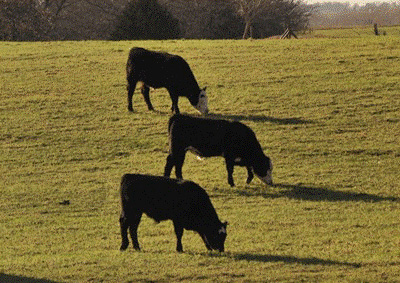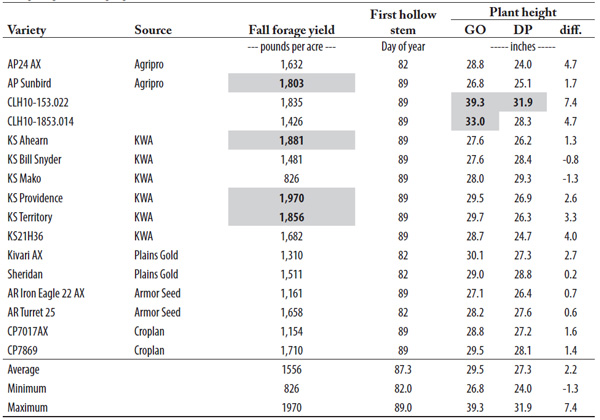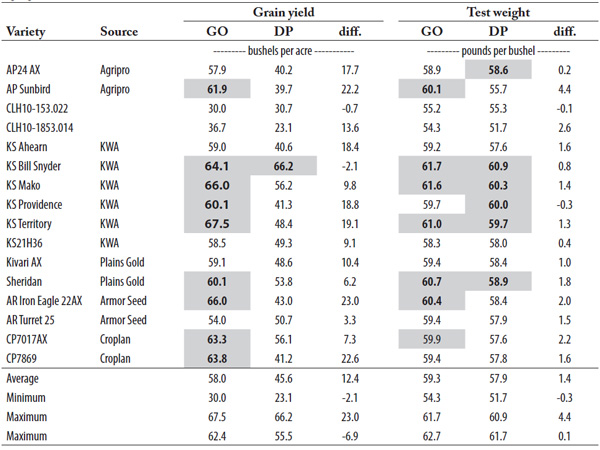An updated publication is now available in the Wheat Rx series that examines the performance of several wheat varieties grown for use in a dual-purpose system (grazing and grain). To be successful in dual-purpose systems, wheat varieties require traits sometimes overlooked in grain-only systems. These include fall forage yield, date of first hollow stem, grazing recovery potential, resistance to viral diseases transmitted when the crop is planted early, no high-temperature germination sensitivity, long coleoptile, and greater tolerance to low soil pH and aluminum toxicity.
This publication evaluates fall forage yield, date of first hollow stem, plant height, grain yield, and test weight of current varieties in a dual-purpose system versus a grain-only system.

This article summarizes information from the publication. The full publication, MF3312 Dual-Purpose Wheat Variety Performance, is available online at: https://bookstore.ksre.ksu.edu/pubs/MF3312.pdf. Wheat Rx is a partnership between Kansas Wheat and K-State Research and Extension to disseminate the latest research recommendations for high-yielding and high-quality wheat to Kansas wheat farmers.
Fall forage yield is an important trait in dual-purpose systems because it sets the potential for beef production from wheat grazing in the fall, winter, and early spring. Approximately 100 pounds of beef per acre can be produced for every 1,000 pounds of wheat forage produced in an acre. Forage production depends on variety, planting date, seeding and nitrogen rates, fall temperature, and precipitation.
The date of the first hollow stem is also an important trait in dual-purpose systems because terminating grazing at the right time is essential to maintaining the grain yield potential for subsequent harvest. Grazing past the first hollow stem can decrease wheat grain yield by as much as 1 to 5% per day.
Depending on environmental conditions, varieties with a shorter vernalization requirement might reach first hollow stem 15 to 20 days earlier than varieties with a longer vernalization requirement. An earlier occurrence of first hollow stem reduces the grazing window into early spring. The date of first hollow stem is dependent on temperature and day length.
Grain yield following grazing is another variety-specific trait important in dual-purpose systems. Varieties that rely mostly on fall-formed tillers to produce grain yield generally show a greater yield penalty due to grazing than varieties with a good spring tiller potential.
Description of site and methods
Sixteen commonly grown winter wheat varieties, as well as pre-release lines, were sown in three neighboring trials in the South Central Experiment Field near Hutchinson, Kansas. Two trials were sown to simulate dual-purpose management, characterized by an early sowing date, increased nitrogen rate, and higher seeding rate, while a third trial was sown using the same varieties under grain-only management. The full publication provides more information on the experiment methods and site characteristics.
Fall forage yield
Fall forage production of the varieties evaluated ranged from 826 to 1,970 pounds of dry matter per acre, averaging 1,556 pounds of dry matter per acre (Table 1). There were significant statistical differences among the varieties, with AP Sunbird, KS Ahearn, KS Providence, and KS Territory falling into the highest forage-yielding group (range within the highest-yielding group: 1,803 to 1,970 pounds of dry matter per acre).
First hollow stem
First hollow stem is reported in the day of year format. For reference, day of year 80 is equivalent to March 21. The average occurrence of first hollow stem was day 87 (Table 3), ranging from day of year 82 for early varieties to day of year 89 for late varieties. These dates represent a normal to slightly delayed release from winter dormancy. The range in first hollow stem was narrow, with all studied varieties reaching first hollow stem within a 7-day interval. Four varieties reached it early (AP24 AX, Kivari AX, Sheridan, and AR Turret 25), and all remaining varieties were past this stage at the subsequent measurement.
Previous reports of the first hollow stem from Oklahoma have shown that early varieties may reach first hollow stem as much as 30 days earlier than later varieties, depending on environmental conditions. Kansas results may differ from Oklahoma results due to cooler winter temperatures holding crop development across varieties, and their interaction with photoperiod as day lengths were already long when temperatures were warm enough to allow for crop development.
Plant height
Varieties and cropping systems also differed significantly in plant height (Table 1). Plant height in the grain-only system averaged 29.5 inches, ranging from 26.8 to 39.3 inches. This average was -1.3 to 7.4 inches taller than the heights measured in the dual-purpose system (27.3 inches average height with a range of 24.0 to 31.9 inches).
Table 1. Fall dry matter forage yield, date of first hollow stem, and plant height under grain-only (GO) and dual-purpose (DP) systems in Hutchinson, KS, during the 2024-25 production year. Shaded values refer to the highest testing group. Values pertaining to the highest group are highlighted in bold.

Grain yield and grain test weight in grain-only or dual-purpose systems
The average grain yield in the grain-only trial was 58.0 bushels per acre, whereas the dual-purpose trial averaged 45.6 bushels per acre (Table 2). Varieties that yielded statistically better than their counterparts in the grain-only trial were AP Sunbird, KS Bill Snyder, KS Mako, KS Providence, KS Territory, Sheridan, AR Iron Eagle 22AX, CP7017AX, and CP7869. The yield penalty from simulated grazing averaged 12.4 bushels per acre and ranged from 2.1 to 23.0 bushels per acre. The variety KS Bill Snyder was the highest-yielding variety of the dual-purpose trial. The weather conditions — characterized by cool and moist grain fill weather — benefited some of the later-maturing wheat varieties this season.
Test weights ranged from 54.3 to 61.7 pounds per bushel in the grain-only system and from 51.7 to 60.9 in the dual-purpose system (Table 2). Varieties with the highest test weight at both grain-only and dual-purpose systems were KS Bill Snyder, KS Mako, KS Territory, and Sheridan, whereas the varieties AP Sunbird, AR Iron Eagle 22AX, and CP7017AX were in the highest test weight group under grain-only, and AP24 AX and KS Providence were in the highest test group in the dual-purpose trial.
Table 2. Winter wheat grain yield and grain test weight in grain-only (GO) and dual-purpose (DP) systems in Hutchinson, KS, during the 2024-25 production year. Shaded values refer to the highest testing group. Values pertaining to the highest group are highlighted in bold.

Romulo Lollato, Extension Wheat and Forage Specialist
lollato@ksu.edu
Jane Lingenfelser, Assistant Agronomist
jling@ksu.edu
Tags: fall forage dual purpose grazing wheat first hollow stem